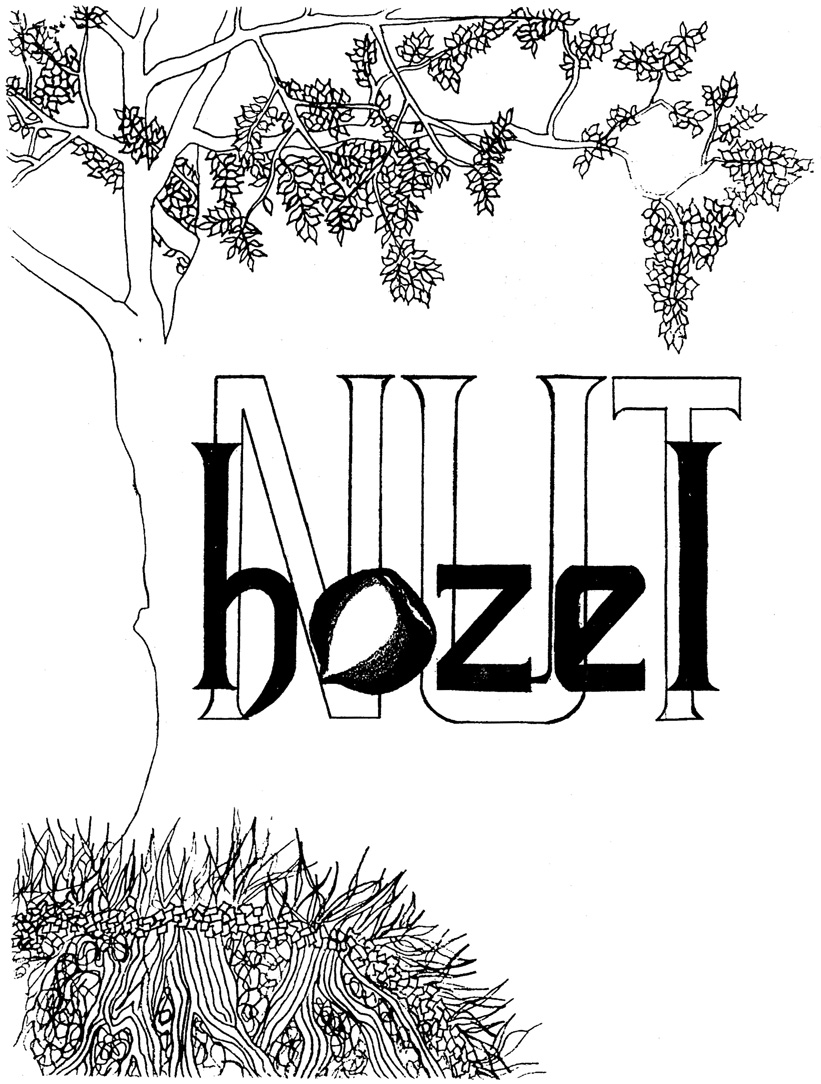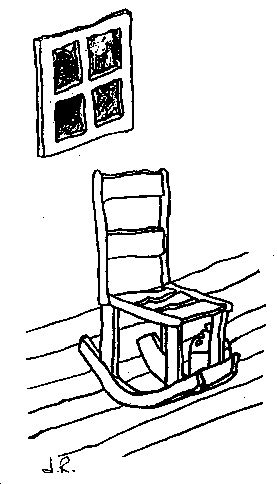

In This Issue:
Out On a Limb: Editorial - Imré Rainey
If You Can Only Use it Once, It's Not Worth Using - Brighid
MoonFire
From Brighid's Hearth: Preparing Herbs - Brighid
MoonFire
Folklore and Practical Uses: Oak - Muirghein ó
Dhún Aonghasa (Linda Kerr)
Lunar Energies and Esoterica: Oak - Epona &
Imré
Poetry: Oak - Fion
Poetry: Neck Pain - Raven
Poetry: Circle - Raven
Mistletoe - Brighid MoonFire
Oak Moon Meditation - Brighid MoonFire
Letters to the Editor
Bubbles From the Cauldron - book reviews, etc.
Staff:
Publisher: The Garden Club
Editor: Imré Rainey
Editorial Assistant: Muirghein ó
Dhún Aonghasa (Linda Kerr)
Staff Writer: Brighid MoonFire (Michelle Bell)
Cover art by Imré Rainey
THE HAZEL NUT, Volume I, Issue 2, Copyright © 1993 The Garden Club. July
1993, Oak Moon. THE HAZEL NUT is published monthly by The Garden
Club. All rights reserved. Copyright reverts to the individual artist or writer upon
publication. No part of this publication may be reproduced without written permission from the
editor and author.
ON ANOTHER NOTE...
Blessed Be! - Imré
Each year Americans throw away:
National Recycling Coalition
202-625-6406
A coalition of recycling companies and organizations.
Coalition for Recyclable Waste
P.O. Box 1091
Absecon, NJ 08201
The Entanglement Network
c/o Defenders of Wildlife
1244 19th St., NW
Washington, DC 20460
202-382-2080
Source:
What Can I Do to Make a Difference? by Richard Zimmerman, 1991, The Penguin Group, New York, NY.
Quercus alba L. -- White Oak. Canada southward to the Gulf of Mexico, as far west as
Texas.
Q. rubra L. -- Northern Red Oak. Same range as White oak.
Q. velutina Lam.- Black Oak. Same range as White Oak.
Q. robur L. -- English Oak. British Isles, Europe, North Africa, West Asia, naturalized in
the
American northeast; planted in southeast and Pacific Coast.
Description & History
Medicinal Uses
Oak Galls
Folklore
'If the Oak's before the Ash,
Then you'll only get a splash;
If the Ash before the Oak,
Then you may expect a soak (24).'
Notes:
(1) Grieve, Mrs. M. A Modern Herbal (2 volumes). 1931. Dover Publications,
Inc., New York,
NY, pg. 594.
(2) Ibid, pg. 595.
(3) Ibid, pg. 594.
(4) Ibid, pg. 594.
(5) Howard-Gordon, Frances. Glastonbury, Maker of Myths. 1982. Gothic
Image, Glastonbury,
England, pg. 45.
(6) Grieve, pg. 595.
(7) Ibid, pg. 595
(8) Hutchens, Alma R. Indian Herbology of North America. First published 1969,
Copyright
1973. Merco, Ontario, Canada. Published in London, England, pg. 207.
(9) Little, Elbert L. The Audobon Society Field Guide to North American Trees,
Eastern Region.
1980. Albert A. Knopf, New York, NY, pg. 277.
(10) Grieve, pg. 596.
(11) Grigson, Geoffrey. The Englishman's Flora. 1955. Phoenix House LTD,
London, England, pg. 250.
(12) Grieve, pg. 596.
(13) Hutchens, pg. 207.
(14) Grieve, pg. 596.
(15) Lust, John. The Herb Book. 1973. Bantam Books, New York, NY, pg.
295.
(16) Hutchens, pg. 207.
(17) Ibid, pg. 207.
(18) Grieve, pg. 596.
(19) Ibid, pg. 597.
(20) Grigson, pg. 252.
(21) Ibid, pg. 250.
(22) Ibid, pg. 250.
(23) Frazer, Sir James George. The Golden Bough. 1922. MacMillan Publishing
Co., New York,
NY, pg. 89.
(24) Grieve, pg. 595.
(25) Grigson, pg. 250-251.
(26) Frazer, pg. 186.
(27) Bonwick, James. Irish Druids and Old Irish Religions. 1986 (written in 1894).
Dorset Press,
U.S., pg. 234.
(28) Grieve, pg. 548.
(29) Ibid, pg. 548.
(30) Bonwick, pg. 235.
(31) Ibid, pg. 235.
(32) Grieve, pg. 307.
(33) Ibid, pg. 594.
(34) Grigson, pg. 254.
Points to look up: Cardea, Janus, Jupiter, chariot (in the tarot), number seven.
Glyph: 'I am a god that sets the head afire with smoke.' Also: 'I am both the oak and the lightening that blasts it.'
(1) This is an allegory describing the Oak. It does not imply ignorance of our ancestors regarding oak physiology, but is a warning that only one who is well grounded in her/himself can possibly survive a test such as fire -- which pervades the lunar month of Oak. [Note that whenever an obvious distortion of reality occurs in a myth, that is where the deepest mysteries lie.]

- by Fion; Duir '93
Lookin' over Baldwin Mountain
watchin' the fire burn
They say that ol' lightening
don't hit three times a turn
But I just saw with my eyes
an oak tree turn to flames
No one to see or say
yet I know it's all the same
Now a little lazy river
just flowed by and by
That flamin', burnin', tree of strength
which no more called the wind
Hercules needed a bucket
but all he had was a club
So the fire kept on burnin'
and nothing could be done
Oh oak tree, oh oak tree
so strong, broad and wide
You've protected me and kept me
from harm's sake by and by
So summer time is on the rise
like the fire from the ground
My feet start to dancin'
it's fire time all around
Impress me, impress me!
the neo-pagan cried.
So we gave him "Woman's Mysteries"
but he said the author lied!
Impress me, impress me!
the neo-pagan said.
So we invited him to classes
but he got bored and went to bed!
Impress me, impress me!
was the neo-pagan's chant.
But when we asked for help to move
said "my back hurts, so I can't!"
Impress me, impress me!
was the neo-pagan's whine.
But when he got his reading list
said "I just don't have the time!"
Impress me, impress me!
was the neo-pagan's demand.
But he scoffed at our High Priestess
and said the boss should be a man!
Impress me, impress me!
was the neo-pagan's shout.
But we stuffed his mouth with cotton
and calmly chucked him OUT!
moonlight
firelight
star shine singing
soul light
glow bright
Goddess song ringing
night song
we belong
offerings now bringing
birds cry
hearts fly
Her praises singing
Sources:
Walker, Barbara. Women's Encyclopedia of Myths & Secrets. 1983.
Harper & Row,
Publishers Inc., New York, NY.
Walker, Barbara. Women's Dictionary of Symbols & Sacred Objects.
1988. Harper & Row,
Publishers Inc., New York, NY.
Mabey, Richard. New Age Herbalist. 1988. Macmillan Publishing Co., New
York, NY.
Hudol, Myrddin. Article: "7 Sacred Herbs of the Druids."
Unto the Editor:
The Real World of Fairies, by Dora van Gelder. 1977. The Theosophical
Publishing House, U.S.
Softcover, $6.95.
- Reviewed by Imré
Devas, Fairies and Angels, by William Bloom. 1986. Gothic Image Publications,
Glastonbury, England.
Softcover, $4.95.
- Reviewed by Imré
The Illuminatus! Trilogy 3-volumes-in-one: The Eye in the Pyramid;
The Golden Apple;
and Leviathan; by Robert Shea and Robert Anton Wilson. 1975. Dell Publishing,
New York, NY.
Fiction (?), Softcover, $12.95.
- Reviewed by Muirghein